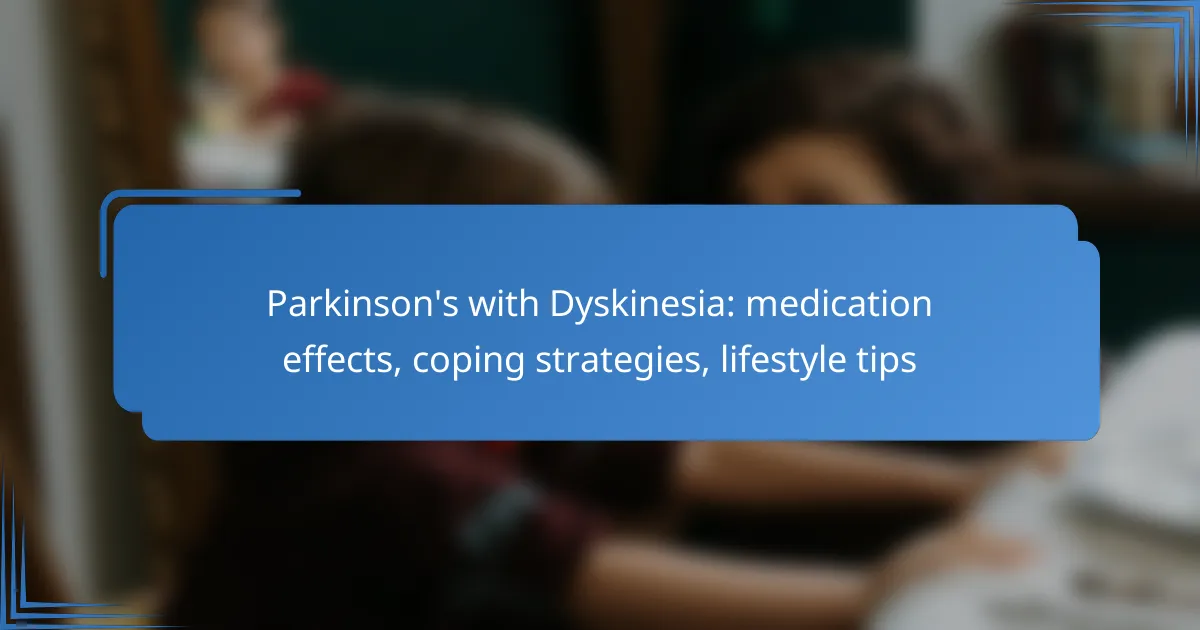Managing Parkinson’s disease with dyskinesia involves a multifaceted approach that includes effective medications, lifestyle changes, and coping strategies. Medications like Levodopa and Amantadine can alleviate symptoms, while regular exercise, a balanced diet, and stress management play crucial roles in enhancing overall well-being. By adopting practical coping strategies, individuals can improve their mobility and foster a supportive community, ultimately enhancing their quality of life.

What are the best medications for Parkinson’s with dyskinesia?
The best medications for managing Parkinson’s with dyskinesia include Levodopa, Amantadine, and various surgical options like deep brain stimulation. Each treatment has unique mechanisms, benefits, and potential side effects that should be carefully considered.
Levodopa
Levodopa is the most effective medication for Parkinson’s disease and is often the first line of treatment. It works by converting into dopamine in the brain, helping to alleviate motor symptoms. However, long-term use can lead to dyskinesia, particularly in advanced stages of the disease.
To minimize dyskinesia, doctors may recommend using Levodopa in combination with other medications or adjusting the dosage. Regular monitoring is essential to find the optimal balance between symptom control and side effects.
Amantadine
Amantadine is an antiviral medication that can help reduce dyskinesia in patients already taking Levodopa. It works by increasing dopamine release and blocking its reuptake, thus enhancing its effects. This medication is often used as an adjunct therapy when dyskinesia becomes problematic.
Patients should be aware of potential side effects, including confusion and hallucinations, particularly in older adults. Starting with a low dose and gradually increasing it can help mitigate these risks.
Deep brain stimulation
Deep brain stimulation (DBS) is a surgical option that involves implanting electrodes in specific brain areas to regulate abnormal signals. It is often considered for patients with severe dyskinesia that do not respond adequately to medication. DBS can significantly improve motor function and reduce dyskinesia symptoms.
Candidates for DBS typically have a stable response to Levodopa and experience motor fluctuations. A thorough evaluation by a neurologist is necessary to determine suitability for this procedure.
COMT inhibitors
COMT inhibitors, such as entacapone, are used to prolong the effects of Levodopa by preventing its breakdown. By doing so, they can help reduce “off” time and improve overall motor control. These medications are particularly useful for patients experiencing fluctuations in their symptoms.
However, COMT inhibitors can also contribute to dyskinesia, especially when used in high doses. Monitoring and adjusting the Levodopa dosage may be necessary to balance efficacy and side effects.
MAO-B inhibitors
MAO-B inhibitors, like rasagiline and selegiline, help increase dopamine levels in the brain by inhibiting its breakdown. These medications can be used alone or in combination with Levodopa to enhance its effects and potentially reduce dyskinesia.
While generally well-tolerated, MAO-B inhibitors can interact with certain foods and medications, leading to dietary restrictions. Patients should consult with their healthcare provider to understand these interactions and manage their treatment effectively.

How can lifestyle changes help manage dyskinesia?
Lifestyle changes can significantly aid in managing dyskinesia by improving overall health and potentially reducing the severity of symptoms. Regular physical activity, a nutritious diet, effective stress management, and good sleep hygiene are key components that can enhance quality of life for individuals with Parkinson’s disease.
Regular exercise
Engaging in regular exercise can help improve motor control and reduce dyskinesia symptoms. Activities such as walking, swimming, or cycling can enhance muscle strength and coordination, which may lead to better movement control.
Aim for at least 150 minutes of moderate aerobic activity each week, along with strength training exercises on two or more days. Always consult with a healthcare provider before starting any new exercise program to ensure safety and appropriateness.
Healthy diet
A balanced diet rich in fruits, vegetables, whole grains, and lean proteins can support overall health and may help manage dyskinesia. Foods high in antioxidants, such as berries and leafy greens, can combat oxidative stress, which is linked to neurodegeneration.
Consider incorporating omega-3 fatty acids found in fish like salmon and walnuts, as they may have neuroprotective effects. Staying hydrated is also crucial; aim for adequate fluid intake throughout the day to support bodily functions.
Stress management techniques
Effective stress management can reduce the frequency and severity of dyskinesia episodes. Techniques such as mindfulness meditation, deep breathing exercises, and yoga can help lower stress levels and promote relaxation.
Setting aside time for hobbies or activities that bring joy can also be beneficial. Consider joining support groups where sharing experiences can provide emotional relief and practical coping strategies.
Sleep hygiene practices
Good sleep hygiene is essential for managing dyskinesia, as poor sleep can exacerbate symptoms. Establish a regular sleep schedule by going to bed and waking up at the same time each day to help regulate your body’s internal clock.
Create a restful environment by keeping the bedroom dark, quiet, and cool. Avoid screens before bedtime and limit caffeine intake in the afternoon and evening to improve sleep quality.

What coping strategies can improve daily life?
Coping strategies for individuals with Parkinson’s and dyskinesia can significantly enhance daily life by providing support and practical solutions. Implementing these strategies can help manage symptoms, improve mobility, and foster a sense of community.
Support groups
Joining support groups can be beneficial for individuals with Parkinson’s and dyskinesia. These groups provide a platform for sharing experiences, discussing challenges, and exchanging coping techniques. Connecting with others who understand the condition can reduce feelings of isolation and promote emotional well-being.
Consider local or online support groups that meet regularly. Engaging in discussions and activities can create a sense of belonging and offer practical advice tailored to your specific needs.
Occupational therapy
Occupational therapy focuses on enhancing daily living skills and promoting independence for those with Parkinson’s. A trained occupational therapist can assess individual needs and recommend strategies to manage daily tasks more effectively. This may include adapting the home environment or suggesting specific techniques for activities like dressing or cooking.
Therapists often provide personalized exercises to improve fine motor skills and coordination, which can help mitigate the effects of dyskinesia. Regular sessions can lead to improved confidence and a greater ability to engage in everyday activities.
Assistive devices
Assistive devices can greatly aid individuals with Parkinson’s in managing their symptoms and enhancing mobility. Common devices include grab bars, walking aids, and specialized utensils designed for easier handling. These tools can help maintain independence and reduce the risk of falls.
When selecting assistive devices, consider consulting with a healthcare professional to ensure the chosen items meet your specific needs. Many devices are available through medical supply stores or online retailers, often with options to suit various budgets.
Mindfulness practices
Mindfulness practices, such as meditation and yoga, can help individuals with Parkinson’s manage stress and improve overall well-being. These techniques encourage relaxation and focus, which can alleviate some symptoms associated with dyskinesia. Regular practice may enhance emotional resilience and promote a positive outlook.
Incorporating mindfulness into your daily routine can be as simple as dedicating a few minutes each day to deep breathing exercises or guided meditation. Many resources, including apps and online classes, are available to help you get started.

What are the side effects of Parkinson’s medications?
Parkinson’s medications can lead to various side effects that may impact daily life. Understanding these effects is crucial for managing symptoms and improving quality of life.
Nausea and vomiting
Nausea and vomiting are common side effects of Parkinson’s medications, particularly when starting new treatments or adjusting dosages. These symptoms can be distressing and may lead to decreased medication adherence.
To mitigate nausea, patients can take medications with food or use anti-nausea drugs as prescribed. Staying hydrated and consuming bland foods may also help alleviate these symptoms.
Confusion and hallucinations
Confusion and hallucinations can occur, especially in older patients or those on higher doses of certain medications. These effects can lead to significant distress and impact safety.
Monitoring mental status and discussing any changes with a healthcare provider is essential. Adjusting medication types or dosages may be necessary to reduce these side effects.
Orthostatic hypotension
Orthostatic hypotension is a drop in blood pressure that occurs when standing up, causing dizziness or fainting. This side effect can be particularly concerning for those with Parkinson’s, as it increases the risk of falls.
To manage orthostatic hypotension, patients should rise slowly from sitting or lying positions and stay well-hydrated. Wearing compression stockings may also help improve circulation and reduce symptoms.

How do medications interact with lifestyle choices?
Medications for Parkinson’s disease can significantly affect lifestyle choices, influencing daily activities, diet, and exercise. Understanding these interactions helps patients manage symptoms and improve quality of life.
Dietary considerations
Diet can impact the effectiveness of Parkinson’s medications. For instance, high-protein meals may interfere with the absorption of certain medications like levodopa. It’s advisable to consume protein-rich foods in moderation and consider timing meals around medication schedules.
Incorporating a balanced diet rich in fruits, vegetables, whole grains, and healthy fats can support overall health. Staying hydrated is also crucial, as dehydration can exacerbate symptoms.
Exercise and physical activity
Regular exercise is essential for managing Parkinson’s symptoms and can enhance the effectiveness of medications. Activities like walking, swimming, and yoga can improve mobility, strength, and balance. Aim for at least 150 minutes of moderate exercise weekly.
It’s important to choose activities that are enjoyable and manageable. Consulting with a physical therapist can help tailor an exercise program that aligns with individual capabilities and medication effects.
Sleep hygiene
Quality sleep is vital for individuals with Parkinson’s, as medications can impact sleep patterns. Establishing a consistent sleep routine, creating a comfortable sleep environment, and avoiding stimulants before bedtime can enhance sleep quality.
If sleep disturbances persist, discussing them with a healthcare provider is crucial, as adjustments to medication or additional treatments may be necessary.
Stress management
Stress can worsen Parkinson’s symptoms and affect medication efficacy. Effective stress management techniques, such as mindfulness, meditation, and deep-breathing exercises, can help maintain emotional well-being.
Engaging in hobbies, social activities, and support groups can also provide emotional support and reduce stress levels. Finding what works best personally is key to managing stress effectively.
